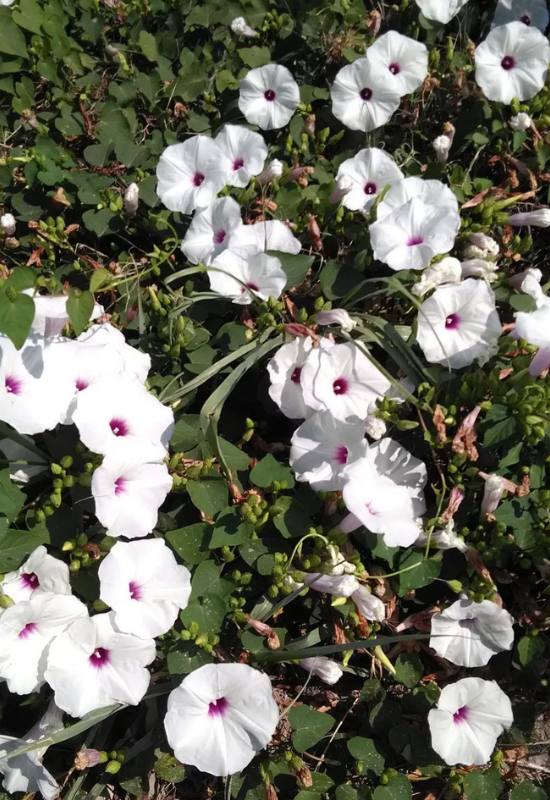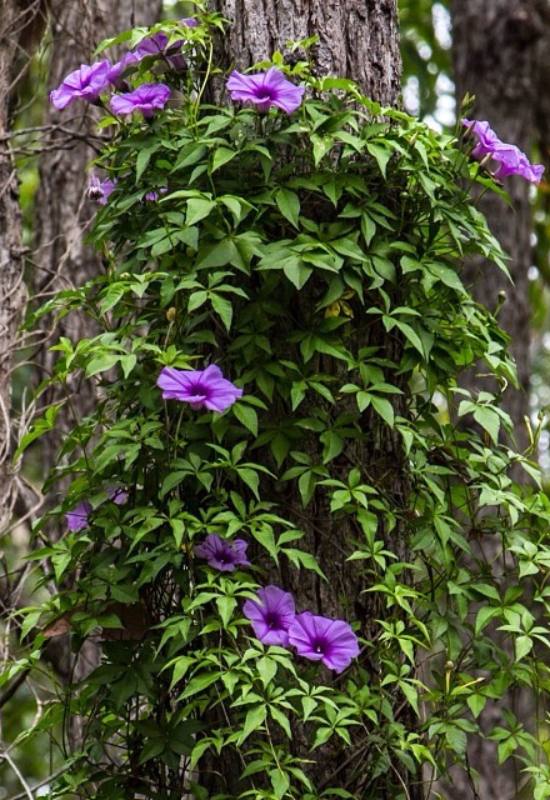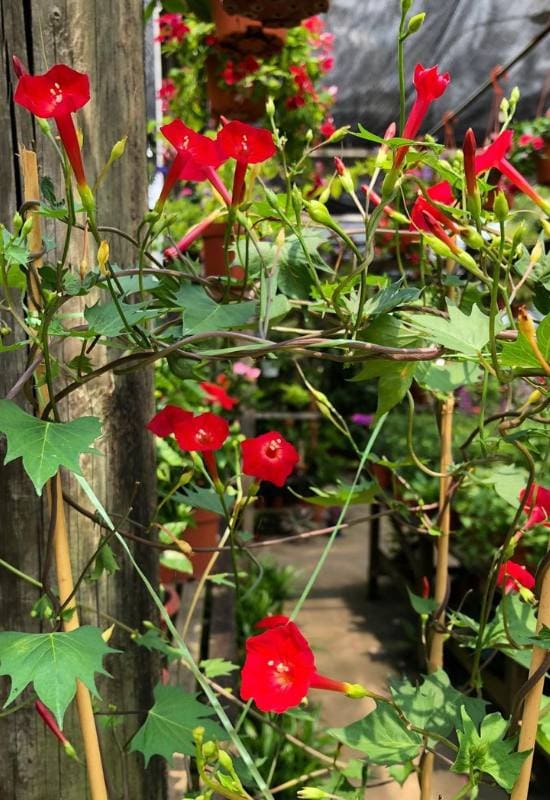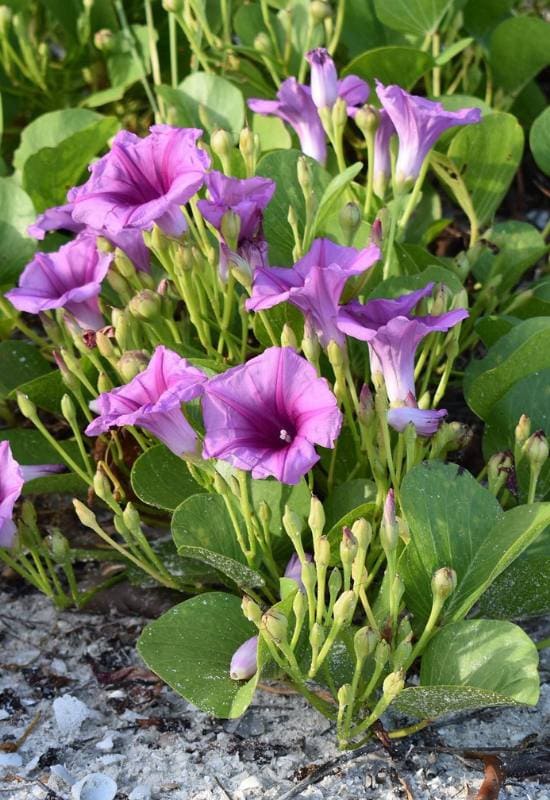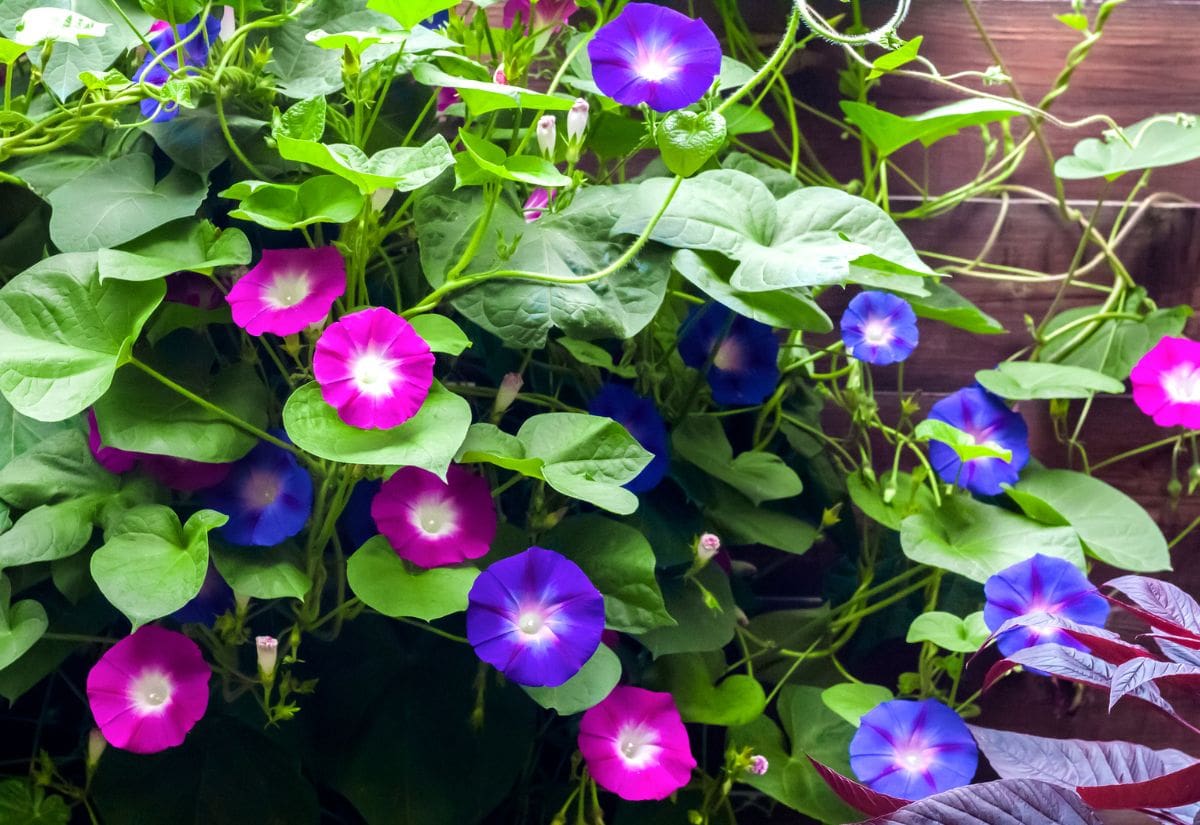
Morning glory varieties explode with funnel shaped, quite large, very colorful and bright flowers that climb on trellises, pergolas, walls and fences and drape them in beauty. They do it for many months, and with generosity! They grow fast and strong, and they want little help at all from you!
White, blue, red, pink, purple or violet, the blossoms of morning glory (or Ipomoea) vines are known for their behavior: they open and close within a day. But it’s not always in the morning, as some bloom at night. And it’s not only in summer’ as some blossom in winter!
Mainly coming from tropical regions, “morning glory” refers to flowering vines, mostly, but also herbs, shrubs and trees of the of the Convolvulaceae family (mainly of the ipomoea genus). It is a large group of plants, comprising 1,650 species, all with funnel shaped flowers.
Within this range, some are properly called “morning glory”, Ipomoea, but also Calystegia and Convoluvulus (these are commonly named “bindweed” as well), while others go by “baby woodrose” (Merremia), “Hawaiian baby woodrose” (Argyreia) and “dodder” (Cuscuta).
Most garden varieties usually like warm climates, but… Some are perennials, others (quite a few!) are annuals you can grow even in cold gardens!
With 600 natural species and many more cultivars, you are really spoilt for choice with types of morning glory vines you can grow, in bloom color, shape, and size, but even the leaves can surprise you, as you will see soon – they are not all heart shaped!
Also known because some varieties are edible, and some hallucinogenic, we picked the best, most famous and most reliable and rewarding garden varieties of morning glory for you!
And now we can start, with natural species, of course, and the most widespread of all! Enjoy!
15 Brightly Colored Morning Glory Varieties To Paint Your Garden with Vibrancy
We have split up Ipomoea varieties into natural species and cultivars, and we selected the most beautiful morning glory types for you. And here they are!
Natural Species of Morning Glory
The Ipomoea genus has many natural species of morning glory, all different in color, but also size and even leaf shape, and here are the most popular with gardeners all over the world.
1: Common Morning Glory (Ipomoea purpurea)
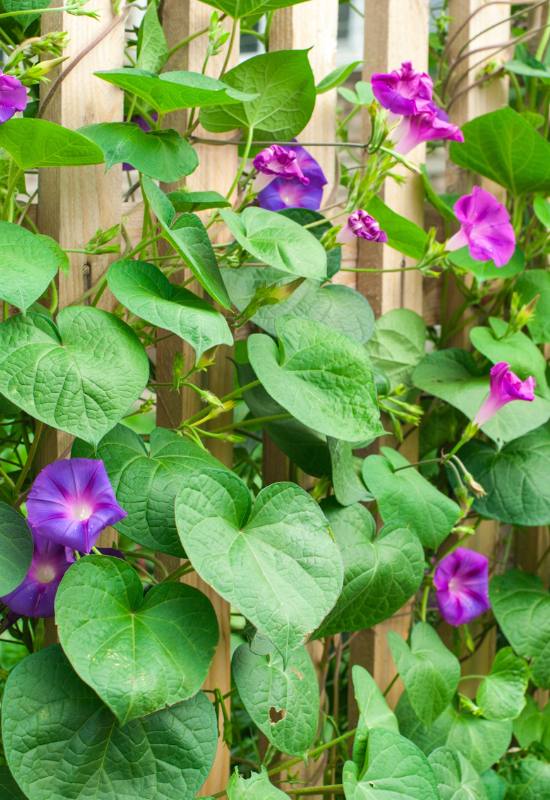
The most classic, most famous, most popular variety of morning glory is a species from Mexico and South America, Ipomoea purpurea. Adaptable and fast growing and usually treated as an annual, it has found new homes all over the world, naturalizing in many areas.
Famous for its funnel shaped flowers with a wide mouth, it it will blow you away with its bright and deep blue, shading into violet and then purple pink rays that lead your eye to the center.
Opening from lavender buds, they will open in the morning and close in the afternoon, but each vine will give you a profusion all through the warm season.
All this on a canvas of semi glossy, rich green heart shaped leaves that hang from the vine. It is also the mother species of many cultivars in a range of colors, which we will see later on.
Super easy to grow, common morning glory will self seed, and it can grow with or without support climbing or crawling, to the point that it may even become invasive.
2: Cardinal Climber (Ipomoea quamoclit)

A totally different variety and one of the most unusual species of Ipomoea is cardinal climber, also known as cypressvine morning glory. The tubular flowers open to a star shaped mouth, with five rays, perfectly triangular…
The name of this tropical American vine comes from the color of the blossoms, which are perfectly scarlet! They are only 1 inch across, or 2.5 cm, but they come generously on cymes starting in early simmer and they are a favorite of humming birds.
The reference to cypress gives us another clue to identify it; the leaves are actually pinnate, so, divided into small leaflets, but they are very thin and they look like soft mid green needles, giving this beauty a soft and fern like appearance
Cardinal climber will need some support, like a trellis, gate etc. to grow, but it will do it fast and vigorously. While it is a perennial in warm and tropical climates, you can easily grow this variety as an annual anywhere, and it will self seed easily as well.
3: Wild Potato Vine (Ipomoea pandurata)
Native of Florida, wild potato vine, or Ipomoea pandurata is a morning glory variety which forms big tubers underground, hence the name. While they are edible, you need to boil them repeatedly and throw away the water, because they contain toxins, while the seeds may contain LSD.
Now, on to the flowers: they are funnel shaped, like most species in this genus and quite broad, about 2 to 3 inches across (5.0 to 7.5 cm). They will come in the warm season and they will open in the morning on sunny days, but in the afternoon if it is cloudy!
White with a bright magenta throat, they will give you a vibrant color display on fences and trellises, even in naturalized or wild settings. The leaves are heart shaped, mid green and large, up to 6 inches long (15 cm).
Wild potato vine is also one of the hardiest varieties of morning glory, it is virtually pest and disease free and rally suitable to coat walls and fences with little money and very little work on your part.
4: Blue Morning Glory (Ipomoea indica)
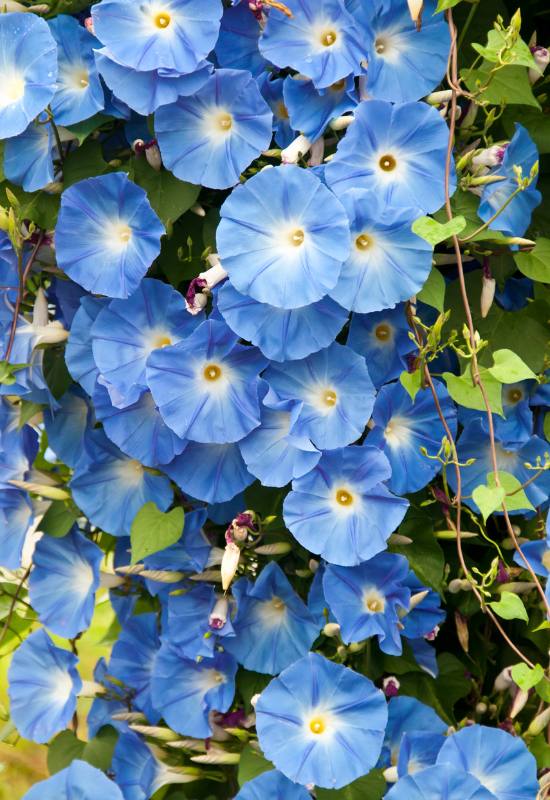
Known for its large and showy funnel shaped blossoms, blue morning glory is a garden favorite. In fact, its flowers reach 4 inches across (10 cm), and they come in generous clusters on this vigorous evergreen twining vine.
Of course, the color is what sets this variety apart, and gives it its name, thanks to its bright and strong indigo to ultramarine shade. The rays that lead you to the throat of the bloom are bright lavender pink instead, and they almost look like they literally shine of a light of their own.
Native of many tropical regions of the world, it will also offer you big, deep green and heart shaped leaves. Having won the prestigious Award of Garden Merit by the Royal Horticultural Society, it has a very long season as well, starting in late spring.
Collect the seeds in fall if you want to have it again in temperate gardens, whether as a climber on fences and pergolas, falling from hanging baskets, or crawling on your land as ground cover.
5: Coastal Morning Glory (Ipomoea cordatotriloba)
Coastal morning glory has a wild look, like a spontaneous vine, and in fact it naturalized very easily. This species comes from Mexico, South America and the Souther States, but you can see it on the edges of fields all over the world…
Its funnel shaped, lavender pink blooms will start their display a bit later than other varieties, in mid summer, sometimes blushing to purple shades, and about 2 inches across (5.0 cm).
They will last one day but follow in quick succession on cymes of up to 5… vigorous and fast growing, this vine will attract butterflies and pollinators, while you can easily identify it by its foliage.
Unlike other Ipomoea types, in fact, the bright to mid green leaves have three deep lobes, and they provide shelter to small animals and birds, thanks to their lush and dense growth.
Very easy to grow and self seeding, coastal morning glory can even become invasive, and this makes it ideal for naturalized areas.
6: Moonflower (Ipomoea alba)
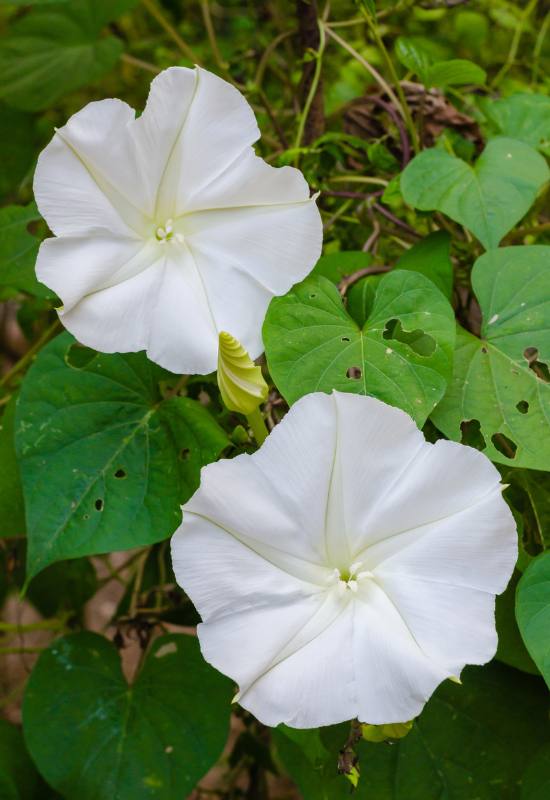
Also called tropical white morning glory, Ipomoea alba, or moonflower has a very strange behavior: its ivory funnel shaped flowers will open in the evening, unlike most other varieties, but at that time of the day, you will also smell their sweet fragrance!
Spreading all through the night, they reach 6 inches across (15 cm) in the morning, when they appear flat, before furling up again. That’s why it takes its name from our satellite, the Moon.
It will also give you dense and deep green foliage, with its heart shaped leaves. It too is a string twining species, which grows fast and self seeds, so, if you cannot grow it as a perennial because you live in a temperate region, treat it as an annual.
Perfect to perfume your garden at night, and to fill your fences with its showy white blossoms, moonflower is ideal on a trellis or pergolas where you can enjoy it if you throw dinner parties during the warm season.
7: Scarlet Creeper (Ipomoea hederifolia)
Scarlet creeper will give you lots of bright red, long, slender and funnel shaped flowers that appear to float in the air, because the come on very thin petioles, and they have long protruding white pistils with large anthers.
If you look inside, you will notice that the throat of the blossoms also displays a golden throat, which attracts humming broad and butterflies! It is also original because the blooms will start their display in summer and keep going all through winter, but only in warm countries.
Rather than a morning glory, it is a night glory, because it blossoms when the Sun sets…The leaves of this annual vine are quite big, up to 6 inches long, or 15 cm, and three lobed.
Ideal for road sides, fences and trellises, scarlet creeper can be propagated by seeds or cuttings. Native of Brazil, it has become invasive in many tropical regions.
8: Beach Morning Glory (Ipomoea imperati)
Native of coastlines of most tropical regions in the world, beach morning glory is perfect for sand dunes and coastal gardens. It is a crawling vine that spreads over the soil, and, starting in early summer. It will also cover itwith showy snow white flowers.
Typically funnel shaped, they are about 2 inches across (5.0 cm) and they look up to the sky in the morning, but they will start closing in the early hours of the afternoon. If you look at them closely, you will also see a canary yellow spot in the center, that leads you to the throat.
Butterflies will see it too, as will hummingbirds, while its seed pods will attract birds and small mammals to feed. The oval evergreen leaves are small and quite fleshy, and particularly glossy too, of a deep green shade. The two back lobes retain a hint of the heart shape we find in other varieties.
If you have a coastal garden, beach morning glory is an ideal vine to grow as ground cover, as well as to keep dunes stable and help local wildlife. It will even tolerate salt water sprays, so you can literally grow it to the foreshore!
9: Railroad Vine (Ipomoea pes-caprae)
Railroad vine has much in common with beach morning glory, and in fact it too os sometimes called this way.
But it is bigger, bolder, and it has more stamina when it comes to floral displays… In fact, it will start blossoming in late spring, but it will continue all the way through summer, then fall, and then winter.
The lavender colored and funnel shaped flowers reach about 2 inches across (5.0 cm) and they will stay open from early morning to mid afternoon. The shade will darken and become more intense towards the center of the flowers, where it turns purple.
Native of many tropical areas around the world, it will still do a great job when it tales its small pause, because it has very decorative evergreen foliage too! The bright green, fleshy leaves with regular lighter veins are gently folded in the middle and they tend to point up to the sky.
Railroad vine is perfect for large groundcover jobs in coastal gardens, even to steady dunes and stop erosion. It will spread fast and even naturalized, helping the ecosystem.
Cultivars of Morning Glory
Breeders have crossed or selected Ipomoea varieties, introducing many cultivars to gardening, bringing out unusual colors and giving us creative color combinations.
10: ‘Carnevale di Venezia’ Morning Glory (Ipomoea purpurea ‘Carnevale di Venezia’)
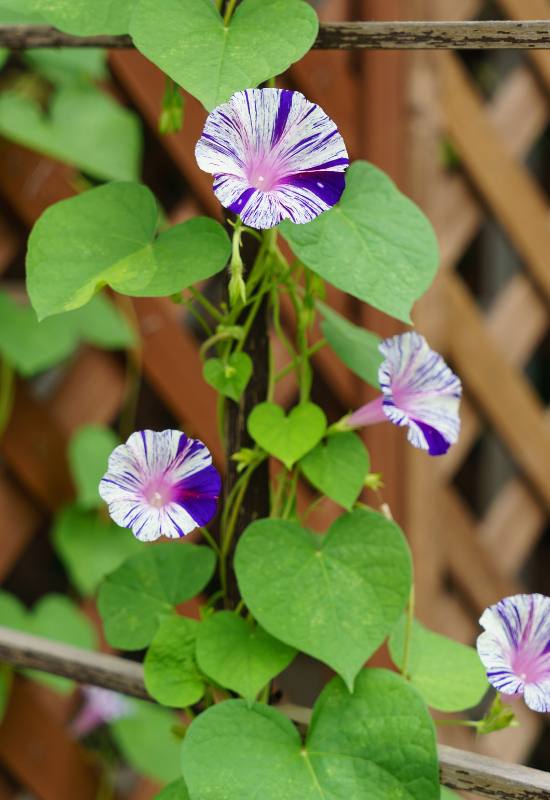
There must be a reason why ‘Carnevale di Venezia’ is one of the most popular and best loved morning glory cultivars by gardeners all over the world…
Just look at its flowers and you will understand why… Funnel shaped like its mother species, Ipomoea purpurea, about 2 to 3 inches across (5.0 to 7.5 cm) and coming in great profusion through summer and into fall.
The blossoms display stripes of white that radiate from the throat to the edges of the petals, like rays. These contrast very much with the magenta or violet lines that alternate with them!
The blossoms will open in the morning and close by sunset. Very colorful and playful, this fast growing vine also has deep green and lush, heart shaped leaves that will coat your fence or trellis with their fresh presence.
Easy to grow and very undemanding, ‘Carnevale di Venezia’ morning glory will soon start its blooming season. You can reproduce it by seed, but the second generation may lose some of its showy stripes…
11: ‘Heavenly Blue’ Morning Glory (Ipomoea tricolor ‘Heavenly Blue’)
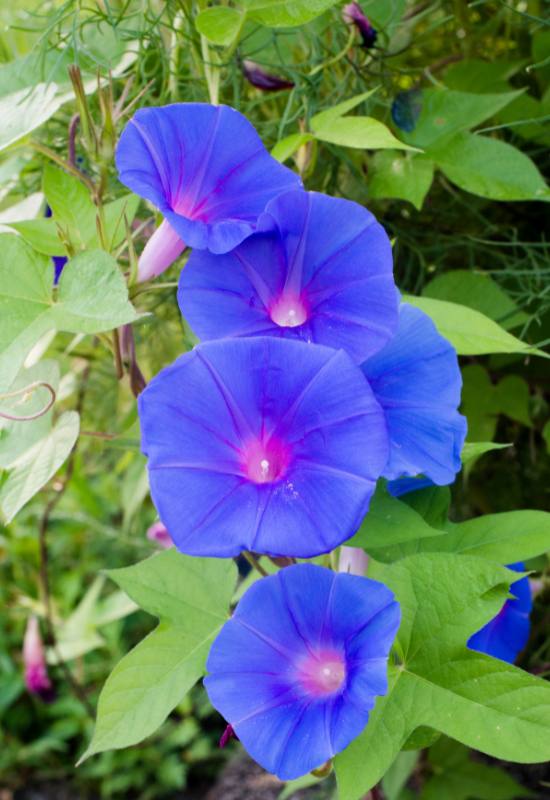
‘Heavenly Blue’ is an extraordinary cultivar of morning glory, and winner of the Award of Garden Merit by the Royal Horticultural Society- for good reason! The large flowers of this annual vine are funnel shaped, like most varieties, but they reach a whopping 5 inches across (12.5cm)!
If this wasn’t enough, the blossoms also have an incredibly strong and bright, deep cerulean blue color! It is a very unusual, striking and rare shade to obtain… Fading to white when you get close to the throat, they lead you to a golden spot that shines from deep inside.
The blooming season starts in early summer and you will get the daily spectacle of opening blossoms in the morning and then furling in the afternoon. The hear shaped, emerald green leaves offer ana airy setting for this impressive floral display.
Despite being spectacular, ‘Heavenly Blue’ morning glory is super easy to grow directly from seed, and for sure it will give your trellis, fence, wall or pergola an unusual but sophisticated look.
12: ‘Grandpa Ott’ Japanese Morning Glory (Ipomoea nil ‘Grandpa Ott’)
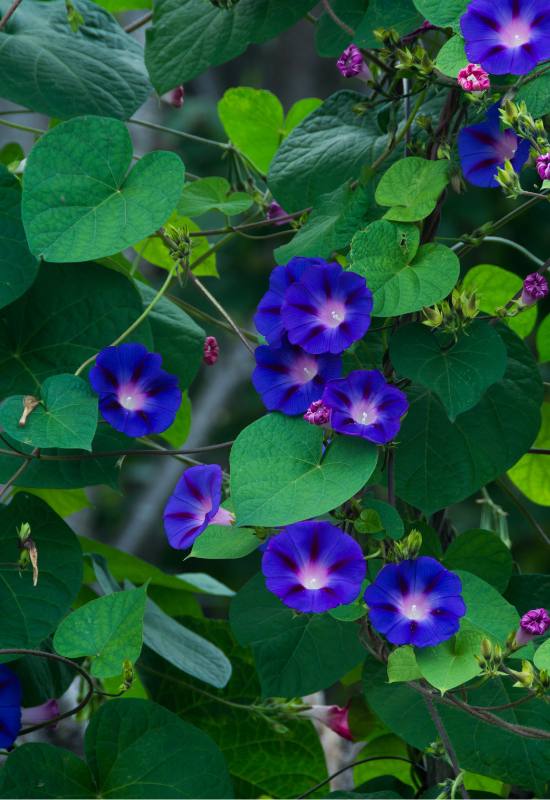
Bred from an Ipomoea species native of Japan, ‘Grandpa Ott’ morning glory is a sumptuous and luxurious cultivar, like few others.
This is mainly due to the intense purple of its flowers, which has a velvety violet shade, but with burgundy rays that lead you to the throat, where it brightens to magenta and finally ends in shiny bright white!
It really looks like it has a light of its own, like a bulb hidden down the funnel! Reaching 2 to 3 inches across (5.0 to 7.5 cm), they open every morning from early summer to fall, and then they close in the afternoon, like most other varieties.
But unlike them, this annual twiningclimber has fuzzy foliage, covered in thin hairs. The bright emerald tonality and heart shape of the leaves conclude the spectacle in style.
Despite its expensive look, ‘Grandpa Ott’ Japanese morning glory is an easy to grow variety you can have from seed, and it will work well, and give you its full floral display in every climate!
13: ‘Seta’ Morning Glory (Ipomoea purpurea ‘Seta’)

If you prefer bright elegance for your trellis, pergola, wall or fence, the Ipomoea purpurea cultivar ‘Seta’ is what you are looking for. This morning glory vine has snow white blooms, but a hint of the five rays remains, like dashes just painted softly by an artist, in a lavender purple shade.
What is more, the edges of the joined petals are gently frilled, giving it a romantic, old world, look, suitable for a wedding event. They will open in the morning and spread to 2 or 3 inches across (5.0 to 7.5 cm), and go to sleep by evening all through the warm season.
Accompanied by mid to deep green heart shaped leaves, forming a dense backdrop, they will certainly bring lots of light and elegance to your garden.
‘Seta’ may well be one of the most delicate looking varieties of morning glory; grow it where you can look at it at close range, so you can enjoy its very refined blossoms.
14: ‘Knowlia’s Black’ Morning Glory (Ipomoea purpurea ‘Knowlia’s Black’)
From pale and delicate to dark and sumptuous, ‘Knowlia’s Black’ morning glory is the Mr. Hyde of ‘Seta’… The reason is simple… The breeder brought out the darkest possible purple shade of this genus, Ipomoea, so the broad and funnel shaped flowers look like the velvet you find in royal palaces or in cathedral draping…This is also thanks to the soft texture of the petals, which open to reach 3 inches across (7.5 cm).
But the lush effect is heightened by the white center, which is surrounded by a pink, magenta to shocking, which surrounds it. It looks as if light emanates from its throat.
It will follow the blooming the mother species, opening in the morning every day from early summer to fall and closing by mid afternoon, but…
The deep green and cordate (heart shaped foliage) has a final twist for your garden: it has clearly drawn veins that make the leaves very decorative.
If you want luxury, ‘Knowlia’s Black’ is the morning glory variety you need; suitable to all climates and garden styles, this annual vine is a real treasure trove!
15: ‘Tie Dye’ Japanese Morning Glory (Ipomoea nil ‘Tie Dye’)
We conclude with the pointillist cultivar of the Ipomoeagenus: ‘Tie Dye’ Japanese morning glory! In fact, rather than flowers, its floral display looks like a canvas by George Pierre Seurat!
In about 2 to 3 inches of space (5.0 to 7.5 cm), they pack in so many little spots that you will never be able to count them all. The dots are lavender bluish, on the violet range, very fine and scattered over a pure white backdrop that folds into the throat of the blossoms.
What is more, the petals are joined, but lobed, rather than flat at the edges, which sets this variety apart from most others. Bright green and heart shaped leaves set off this intricate and decorative spectacle, and the fine hair on the foliage gives it a soft and lush appearance.
‘Tie Dye’ is a unique cultivar of morning glory that is best appreciated at close distance; you don’t want to miss the delicate beauty of its elegant spots, so, grow it close to home, on a gazebo, or where you spend a lot of time.
Morning Glory Varieties for All Gardens
While morning glory is a tropical vine, there are varieties that grow even in cold regions. And the range of colors and even shapes – of the leaves too! –you can get with the many natural species and cultivars will suit any need or taste.
So, if you have a wall, fence, pergola or trellis, or even some barren ground to cover, and you like showy, colorful and funnel shaped blossoms, for sure you are spoilt for choice!

Written By
Adriano Bulla
After many years as an academic in London, Adriano Bulla became a writer, publishing books like A History of Gardening, Organic Gardening and Elements of Garden Design; he then decided to become a gardener, following his childhood dream, and has been following his dream writing and gardening professionally in Southern Europe, where he has specialized in new and innovative organic gardening fields and techniques, like permaculture, regenerative agriculture, food forests and hydroponics.

